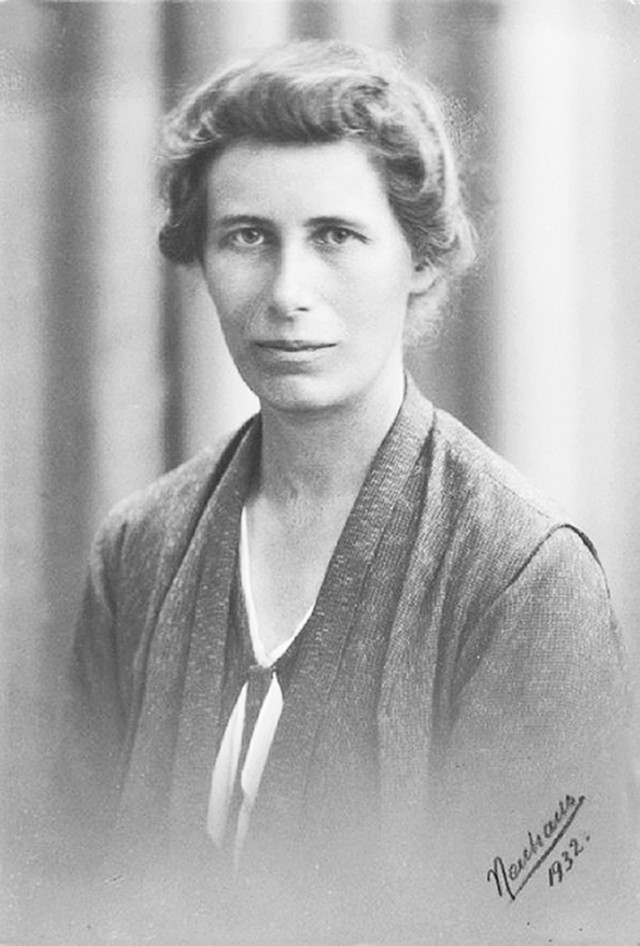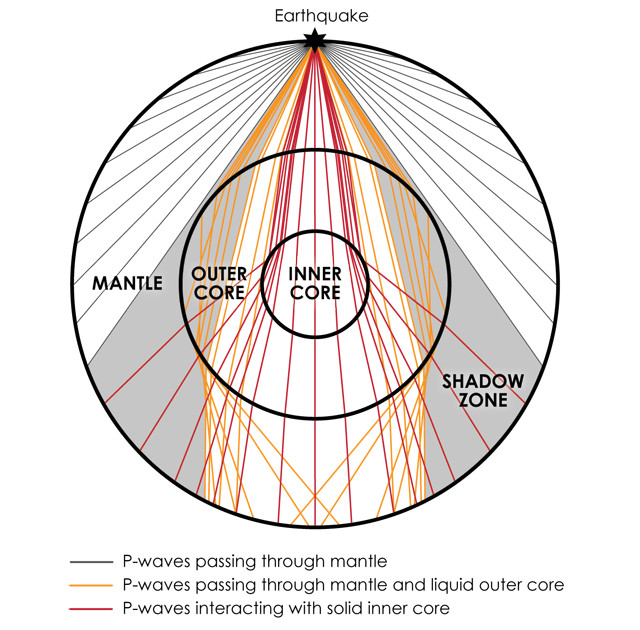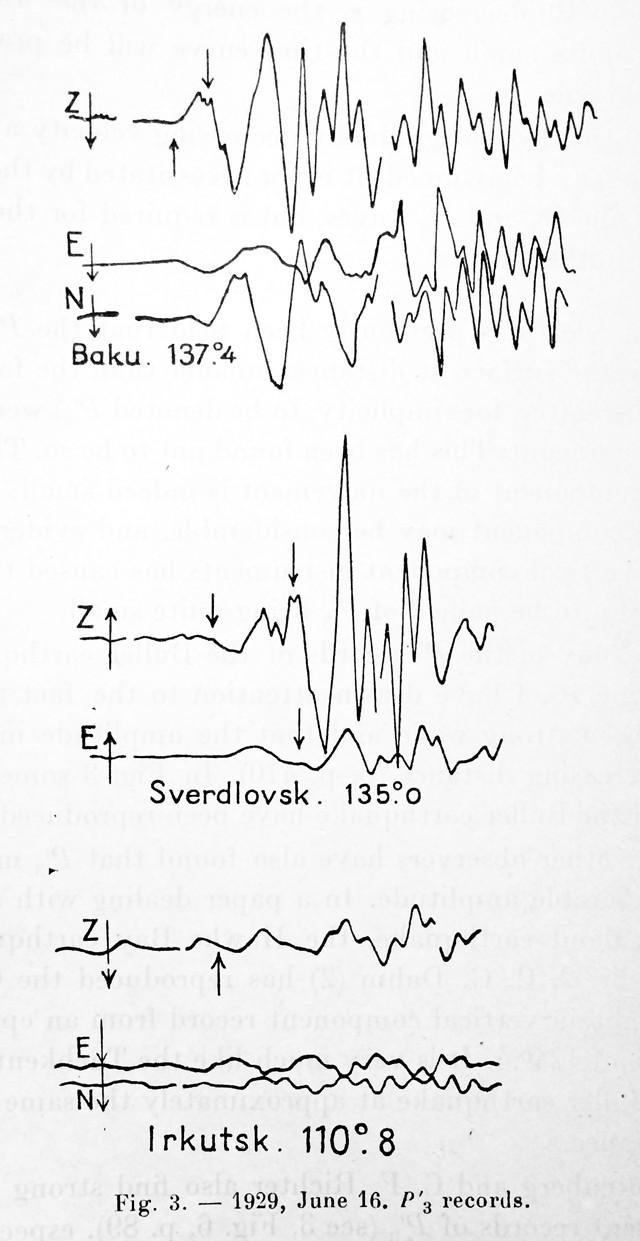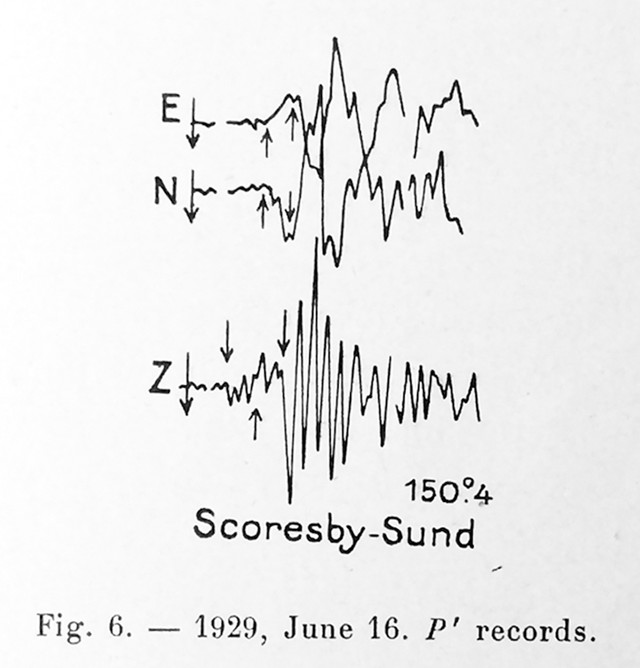
by Allison Mills Friday, January 30, 2015

Inge Lehmann worked for the Royal Danish Geodetic Institute from 1925 to 1952, heading the seismology department from 1928 until her retirement. Credit: The Royal Library, National Library of Denmark and University of Copenhagen University Library.
On March 29, 1936, Danish seismologist Inge Lehmann wrote a letter to a colleague in which she argued that seismic waves — specifically P-waves — recorded from distant earthquakes showed some anomalous characteristics. “If you had seen so many records from these distances as I have,” she wrote, “I am sure you would not doubt that the amplitudes are abnormally small.” Within the year, Lehmann published a study based on those unusual amplitudes, work that first proposed that Earth has a solid inner core inside its liquid outer core.
Lehmann’s letters reveal the process behind the discovery, which involved extensive and painstaking calculations of earthquake waves generated halfway around the world. Completed at a time when seismographs were much less sensitive, the detailed work unveiled a mystery and opened a new line of inquiry in geophysics.
The difficulty with studying Earth’s interior is that fieldwork is impossible. The core’s properties and characteristics need to be studied from afar using seismic waves.
When part of Earth’s crust ruptures, shock waves spread out from the hypocenter. There are several kinds of waves, but two in particular help scientists study the deep interior: P-waves and S-waves. (“P” and “S” stand for “primary” and “secondary,” or alternatively for “pressure” and “shear.”) Because P-waves propagate more quickly, they are the first to arrive at seismometers. Differences between the arrival times of P- and S-waves allow seismologists to determine the distance between where an earthquake occurred and where it was detected.

This simplified three-shell model of Earth proposed by Lehmann in 1936 shows that P-waves discovered within the shadow zone are caused by their interaction with a solid inner core. In reality, seismic waves curve as they travel through the layers of Earth. Credit: Kathleen Cantner, AGI, based on Lehmann's original figure, redrawn in Kölbl-Ebert, 2001.
The behavior of waves is affected by the nature of the material through which they propagate — for example, whether rock is liquid or solid. S-waves, the slower, undulating shear waves, cannot travel through liquid and are deflected at the edge of the outer core. This causes a “shadow zone” on the opposite side of Earth where seismometers don’t pick up S-wave readings. P-waves, which are faster, compressional waves, can travel through both liquid and solid material — but liquid refracts the waves, causing another shadow zone. When these refracted waves hit the solid inner core, their velocity changes again and causes indirect, amplified readings directly across Earth from the epicenter.
By the time Lehmann pored over her earthquake wave data, geologists at the turn of the century had hypothesized the existence of a core based on S-wave deflection, and Harold Jeffreys determined in 1926 that it must be fluid to do so. While early seismologists had noted the P- and S-wave shadow zones created by the outer core, seismograph readings were not fine-tuned enough to pick up indirect P-wave signals from the solid inner core.
These old seismographs were simple but elegant machines: They functioned by suspending a free mass from a support that was anchored to the ground. During an earthquake, the anchor and support would move with the ground motion while the free mass remained stationary — the ground motion caused by an earthquake was recorded in real-time by a pen, attached to the free mass, on a drum of paper. The same principles are at work with modern seismometers, but older models were less sensitive to distant earthquake waves, which fade in intensity farther from the epicenter.

Scoresby Sund in Greenland was one of the farthest reaches of the Danish seismic stations. Lehmann's vast array of seismographs helped her detect earthquakes around the world. Credit: ©Hannes Grobe, CC BY-SA 2.5.
Lehmann and contemporary seismologists used these paper readings to calculate the distance and intensity of earthquake motions across the world.

Seismograph readings from around the world led Lehmann to hypothesize a solid inner core. Credit: Lehmann, I., 1936, "P'".
A leading seismologist globally in her time, Lehmann once recalled that she was “the only Danish seismologist for 25 years.” Denmark, after all, is not noted for its earthshaking quakes. During the late 1920s and 1930s, Lehmann helped begin, and later directed, the establishment of seismograph stations across Denmark and Greenland. With this far-reaching array, she received readings of earthquakes from across the world. The locations of her seismograph stations — opposite several earthquake hot spots — granted Lehmann unique insight into how earthquake waves traveled great distances.
Although her ultimate conclusion may have been massive in scope, Lehmann’s day-to-day work was hardly grandiose; the calculations she made were minute and painstaking. A prolific letter writer, Lehmann laid out some of her thoughts and calculations in notes to colleagues, most notably Harold Jeffreys in Cambridge, England. Four years before publishing her theories on the inner core, she wrote about them to Jeffreys and the two exchanged considerations of Earth’s inner mysteries.
In the years preceding World War II, an informal international seismology community grew in Europe and exchanged data, which gave Lehmann, Jeffreys and their colleagues access to myriad earthquake readings across the continent. Lehmann, who had worked in an actuary’s office during a hiatus from academia, received extensive mathematical training, which gave her the skill to exact detailed analyses using the P-wave data. Her younger cousin, Nils Groes, wrote about Lehmann’s process:
“I remember Inge one Sunday in her beloved garden on Søbakkevej; it was in the summer, and she sat on the lawn at a big table, filled with cardboard oatmeal boxes. In the boxes were cardboard cards with information on earthquakes and the times for their registration all over the world. This was before computer processing was available, but the system was the same. With her cardboard cards and her oatmeal boxes, Inge registered the velocity of propagation of the earthquakes to all parts of the globe. By means of this information, she deduced new theories of the inner parts of the Earth.”
While Lehmann made many contributions to seismology, her most notable theory was the one presented in her succinctly titled 1936 paper “P’” (P prime), which first proposed the existence of a solid inner core. (The paper’s title is based on the notation for refracted primary waves.)
“P is used to denote longitudinal or ‘pressure’ seismic waves. Those that travel in the Earth’s mantle and crust only are represented by P; P’ represents P-waves that pass through the mantle into the core, and then pass through the mantle again,” she explained.
In the paper, the calculations and figures that Lehmann presented were greatly simplified in order to more accessibly examine the phenomena she observed in the earthquake wave data. Lehmann used a single case study to test her hypothesis — for example, straightening out the naturally arced trajectories of P-waves to ease calculations of their angles and velocity changes.

A New Zealand earthquake in 1929 served as a case study for Lehmann's initial solid core theory. Credit: Lehmann, I., 1936, "P'".
Her analysis focused on the P-wave readings from one quake in particular, the 1929 earthquake in Buller, New Zealand, which revealed a puzzling anomaly. Two seismograph stations recorded unusually large P-wave amplitudes, although they each were squarely within the shadow zone. Were Earth’s core indeed entirely liquid, these stations should not have detected these particular earthquake waves. This discrepancy led Lehmann to examine the P-wave travel times and amplitudes in further detail from seismograph stations across Europe.
This was the data to which Groes referred, which she wrote on cardboard cards, and analyzed and correlated by hand. The model she drew from the data proposed a three-shell diagram of Earth’s interior with the solid mantle, liquid outer core and solid inner core.
Today, the existence of a solid inner core is a fundamental tenet of geophysics. The discovery, however, was revolutionary at the time, especially because the only data available were often messy and inconsistent seismograph readings. Fellow seismologists were quickly won over by the clarity of Lehmann’s idea. And in the years following publication of her theory, other notable researchers, including Jeffreys, augmented Lehmann’s model, offering further evidence for the existence of an inner core. However, determining P-wave velocities through the inner core remained controversial for decades.
While the initial research remained compelling, there was much physical data still to be gathered to refine a basic understanding of the inner core. By the late 1960s, seismometer technology had advanced substantially, and in 1970, a study was published confirming observations of a refraction zone where the P-waves were distorted by the inner core’s solidity. Research that followed focused on the inner core’s physical properties, including analyses of its density and attempts to determine how and why the inner core rotates differently than the outer core.
Lehmann moved on to researching the upper mantle and, after retiring in Denmark, often traveled to the United States for extended research opportunities. She lived to be 104 years old and kept all her original letters, notes and writings about her early seismology research. The materials are now kept at the Danish National Archives, and science historians are studying the old correspondence for clues to the historical development of ideas about Earth’s interior.
Today, Lehmann’s methods seem almost quaint. With extensive computing power, elaborate modeling and much more refined equipment, modern seismology has advanced in leaps and bounds from its early- and mid-century practices. But Lehmann’s legacy — her detailed calculations and perceptive observations — demonstrates the irreplaceable power of exacting measurements and creative thinking in geoscience research.
© 2008-2021. All rights reserved. Any copying, redistribution or retransmission of any of the contents of this service without the expressed written permission of the American Geosciences Institute is expressly prohibited. Click here for all copyright requests.